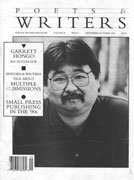The implications are clear, and again Sitter relies on statistics. “In 1965, major publishers brought out well over one hundred books of poetry; in 1988, they published forty-one. If you’re a very well-known poet or novelist, the commercial houses may still be willing to publish you,” he says, “but they will be doing fewer and fewer books by newer writers,” and, he believes, “the chances that they will stay with a new poet or novelist are small.”
Sitter does not think of this as necessarily bad news for serious writers or their readers. “In a giant company,” he explains, “overhead is attributed across the board to all of its products, from glossy gift books to novels. Higher overhead and investment of capital make these companies look for a product with a high degree of profit, and a high predictability of profit.” He believes that this trend will continue, with publishers looking for more consistent bestsellers like the books of Stephen King. “But,” he adds, “as the minimum number of books a large publisher has to sell to break even [currently 10,000 to 15,000] keeps rising, this leaves a huge window of opportunity for small presses,” operation that can still do well selling 3,000 to 5,000 copies of books aimed at a literary audience.
Sitter anticipates that in filling the gap left by larger publishers, small presses and literary magazines will publish many of the outstanding writers across the country, including experimental and multicultural work, that larger publishers are reluctant to bring into print. he believes that the publishing of poetry in particular “has pretty much been signed over to the small presses,” and predicts that by the end of the ‘90s, more major American poets will have grown up with small presses, which will be bigger, better, more competent and adept at promoting their books.
Sitter believes that small presses have already begun this process. “Publishers like Black Sparrow, Coffee House, Copper Canyon, Godine, and Graywolf, which flourished in the 1960s as hand-printing operations, found in the 1970s that the audience for their books had expanded so that editions of three hundred were no longer enough. They grew larger to serve the audience, and they now have good nationwide distribution.









